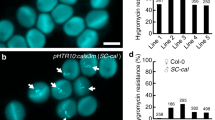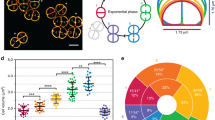Abstract
WHILE carrying out electron microscope studies of pollen development in Tradescantia bracteata we have made observations from sections of glutaraldehyde/osmic fixed material which seem relevant to the problem of the mechanism of release of ribosomes from the nucleus.
This is a preview of subscription content, access via your institution
Access options
Subscribe to this journal
Receive 51 print issues and online access
$199.00 per year
only $3.90 per issue
Buy this article
- Purchase on Springer Link
- Instant access to full article PDF
Prices may be subject to local taxes which are calculated during checkout
Similar content being viewed by others
References
Afzelius, B. A., Exp. Cell Res., 8, 147 (1955).
Rebhun, L. I., J. Biophys. Biochem. Cytol., 2, 93 (1956).
Gall, J. G., J. Biophys. Biochem. Cytol., 2, Suppl. 393 (1956).
Jensen, W. A., and Park, R. B., Cell Ultrastructure (Wadsworth, 1967).
Nørrevang, A., Intern. Rev. Cytol., 23, 113 (1968).
Author information
Authors and Affiliations
Rights and permissions
About this article
Cite this article
MEPHAM, R., LANE, G. Nucleopores and Polyribosome Formation. Nature 221, 288–289 (1969). https://doi.org/10.1038/221288a0
Received:
Revised:
Issue Date:
DOI: https://doi.org/10.1038/221288a0
This article is cited by
-
Freeze-fracture studies on Pneumocystis carinii
Parasitology Research (1987)
-
Post meiotic nucleo-cytoplasmic interaction in Pinus banksiana: The secretion of RNA by the nucleus
Planta (1975)
-
Ethidium bromide and its effect on the nuclear membrane cycle
Protoplasma (1973)
-
The macronuclear envelope ofTetrahymena pyriformis GL in different physiological states
The Journal of Membrane Biology (1972)
-
Actinomycin D and the central granules in the nuclear pore complex: Thin sectioning versus negative staining
Zeitschrift f�r Zellforschung und Mikroskopische Anatomie (1972)
Comments
By submitting a comment you agree to abide by our Terms and Community Guidelines. If you find something abusive or that does not comply with our terms or guidelines please flag it as inappropriate.



